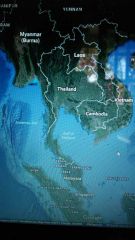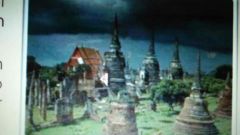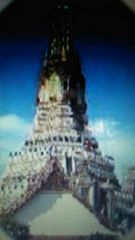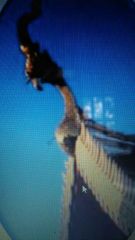![]()
![]()
![]()
Use LEFT and RIGHT arrow keys to navigate between flashcards;
Use UP and DOWN arrow keys to flip the card;
H to show hint;
A reads text to speech;
73 Cards in this Set
- Front
- Back
|
Total Land Boundary |
4863 |
|
|
Borders and boundaries |

|
|
|
Bangkok |
Also called Krung Thep "City of Angels" |
|
|
Thailand |
Prathet Thai "Land of the Free" Previously, Syam, Siem, Syama (sanskrit) "dark brown people" Muang Thai, in coins not siam |
|
|
Tropical Climate |
28-35°C North 3 seasons South 2 seasons |
|
|
National Flower |
Ratchaphruek "Golden Flower" |
|
|
National Animal |
Chang Thai "Thai Elephant" |
|
|
National Architecture |
Sala Thai "Thai-style Arbor" |
|
|
Religion |
Hinayana or Theravada Buddhism Muslim Confucianism Christian Hindu and Sikhs |
|
|
National Religion |
Buddhism |
|
|
Theravada Buddhism |
6th Century 20yrs old male, 3 months monk hood Official Religion by Ramathibodi 1360 |
|
|
Muslim |
Mostly Sunnis 2000 Mosques, 200 Muslim Schools |
|
|
Christians |
16th 17th Century, surgery, smallpox vaccinations, western medicine |
|
|
Christian Denominations |
Catholic Southern Baptists Seventh Day Adventists Church of Christ Evangelical Fellowship |
|
|
Hinduism |
Erawan Shrine Statues of Ganesh, Indra, Shiva Garuda Separate School Teach Sanskrit |
|
|
Sikhism |
Lada Singh 1890 Early 1900s migration 1911 settled Free school, Aiding the aged |
|
|
Ancient Civilization |
Mon-Khmer and Malay 9th -13th Century |
|
|
Sukhothai |
Mid 13th to 15th Centuries 1238 Govs. Khun Bang Klang Tha and Khun Pha Muang independence against Khmers
Golden Age |
|
|
Ayutthaya |
Mid 14th - 18th Centuries Founded by King U-Thong Capital on Chao Phraya River |
|
|
Lanna |
Mid 13th - 19th Centuries Centered in Chiang Mai King Phya Mangrai Allied with Sukhothai Became Ayutthaya's Vassal (1558 Independence End) Wood, Stone, Bricks, Wat, Temple |
|
|
Rattanakosin |
Late 18th Century to Present Agriculture Vassal States: Cambodia, Laos, Malay Kingdoms |
|
|
Chao Phraya |
Valley, now Central Thailand, home of Mon Dvaravati culture |
|
|
Samuel Beal |
Tou-lo-po-ti |
|
|
George Coedes |
made grand excavation, Nakorn Pathom, center of Dvaravati Culture |
|
|
Dvaravati |
Sanskrit Name |
|
|
Nanchao Period |
650-1250, on SW border of China's Tang Empire 618-907, Tai people migrate to SEA |
|
|
King Ramkhamhaeng |
Most Famous and Dynamic in Sukhothai
Established Thai Alphabet |
|
|
Ayutthaya Rivers |
Chao Phraya Pasak Loburi |
|

|
Phra Nakhon Si Ayutthaya Historical Park |
|
|
Ramathibodi |
Theravada Buddhism Official Religion 400 wats erected |
|
|
Ayutthaya Palaces |
Wang Luan, Royal Palace, Prncpl King Wang Na, Palace of the Front,Vc. King Wang Lang, Palace to the Rear,Prince |
|
|
Stupa |
14th Century Lankawong Buddhism Sect Lanka Style |
|
|
Thon Buri Period |
1767-82 Fall of Ayutthaya 1767 Burmese Armies |
|
|
General Taksin |
1769 King Taksin the Great reunite Thai Kingdom |
|
|
General Chakri |
1782 Rama I succeed mad Taksin Founded Bangkok across Chao Phraya river |
|
|
Lopburi |
Constructed with bricks & cut stones Influences: Mahayana Buddhism sect Hinduism |
|

Prang |
Tall finger-like spire, richly carved (Prang at Wat Arun, Temple of Dawn) |
|
|
In type |
Rama III traditional gable ends |
|
|
Out Type |
Rama III bricks and stucco gable end |
|
|
Geological Materials Cons. |
Brick 12th Century - Vegetable Glue Stucco - lime and glue, terracotta Wood - temple construction Sandstone - door/window parts |
|
|
Geological Materials Orn |
Porcelain Lacquer Gilt Mother-of-pearl Gold Leaf |
|
|
Influence on Thai Arch. |
Burma, China, Khmer, India, Sri Lanka |
|
|
Thai House |
Simple Bamboo and thatch raised of ground Veranda-like outside of sleeping area |
|
|
Central Plains Houses |
Elevated on Stout Round Posts Steep Roof, curved bargeboards Panel Walls leaning inwards |
|
|
Northern Houses |
Walls lean outward Smaller Windows Kalae V-shaped Chigi-like (buffalo horn represent) |
|
|
Northern Rice Barn |
Raised Pillars Ladder Access Few Windows |
|
|
Royal Houses trad. |
Closer to ground Decorative Features |
|

|
Tamnak Daeng House (The Red House) Rama I |
|
|
Ngao |
Gable |
|
|
Sala |
Open-sided Pavillion Living Room |
|
|
Wat |
Thai Temple Most important religous structure School, Hospital, Community Center, Entertainment Venue |
|
|
Columns Capital |
Lotus Bud or Water Lilies - Purity of Buddha's thoughts |
|

Bot |
Also Ubosot Ordination or Assembly Hall Faces East (Wat Benchamabophit) |
|
|
Bai Semas |
Surrounds Bot Sacred Boundary Stones |
|
|
Chedi |
Solid Domeshaped housing buddha relics |
|
|
Vishnu |
Thunderbolt at the top of Chedi Hindu lord of the Universe |
|
|
Wihan |
Second Assembly Hall Usually larger than Bot and
no Bai Sema |
|

Chofa |
Tassel of Air Garuda Form (Wang Pangsank Taii) |
|
|
Mondop |
Square based structure Topped with Cruciform roof or spire |
|
|
Bodhi tree |
Ficus Religosa, Sacred Figar Pipal Tree |
|
|
Cloister |
Main wall enclosing phutthawat |
|
|
Phutthawat |
Main area of Wat Complex |
|
|
Sanghawat |
Monk Living Quarters |
|
|
Ho Rakangs |
Bell Towers |
|
|
Minor Salas |
Meeting place for Pilgrims |
|
|
Ho Trai |
Wat Library housing Holy Scriptures |
|
|
Kuti |
Monk Small House on stilts Sanghathisep, Rule 6, 12x7 Keub |
|
|
Hor Trai |
Stores Scriptures in Kuti |
|
|
Royal Houses royal |
Mix Trad. House, Western, &Thai Wat Teak Wood main structural material |
|
|
Teak Wood |
Rich Red Color |
|
|
Wat Phra |
Known as Grand Palace Residence Group: Dusit Maha Prasat Phra Maha Monthian |
|
|
Phra Maha Monthian |
Audience Hall of Amarin Wintchai - Ceremonies of the Court Paisal Taksin Hall- Octagonal seat coronation Chakrapat Phiman Building |
|
|
Dusit Maha Prasat Hall |
- Audience Hall, Siamese Architecture with perfect proportions Baron Phiman Mansion -Phra Thinang Borom Phiman, King Rama V 1903 till Rama IX |

